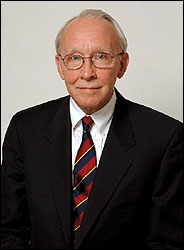
"Daimler did a god awful job."
Despite all the doubts about it long-term viability, Chrysler can survive but they’re going to have to recover from mismanagement at the hands of former partners at Daimler AG according to Chrysler’s former Chief Financial Officer.
“I think they” can survive,” Jerome York said, after an appearance at Oakland University in Rochester Hills, Michigan. “If you believe some of the things they’ve said about breaking even at a relatively low level of sales, and if you believe at some point we’re going to have an (economic) recovery,” then York thinks Chrysler Group will make it.
The U.S. Supreme Court cleared the way for Chrysler’s emergence from bankruptcy this week by declining to hear an appeal by disgruntled creditors, dealers and contingency fee product liability lawyers.
York also said the Italian carmaker Fiat would do a better job of managing Chrysler than Daimler. “I sure hope so because Daimler did a god awful job,” he said. “Daimler should be shot, figuratively speaking of course, for what it did. They left this company in a mess.”
York also called the styling “deplorably bad with a few exceptions; The Jeep brand has only two real Jeeps, the Grand Cherokee and Wrangler and the rest are badge engineered Dodges.” He said, “You can’t treat a brand like that and not do some fatal damage to it.”
“The quality is terrible,” York said. “When you look at the J.D. Power data they are at the bottom of the heap. How can a German engineering company do something like that?” If nothing else what Daimler could have done was help Chrysler gain access to developing countries,” York said. “Mercedes is a potent force,” he said.
York also said it was absolutely necessary for both Chrysler and General Motors to file for bankruptcy protection to spur change and reform both companies.
“They could not have pared down their debt and they could not have dropped dealers,” he said. “It’s too bad GM owns the Renaissance Center,” he said.
With financial capital scarce, the U.S. government take over of both companies also was necessary. “Neither company could have survived without government help,” York said.
“General Motors never got ahead of the curve for the last 10 years or so,” he said. “I’d love to go back and look at how many rounds of restructuring were announced” in the last four years.”
“When this terrible financial crisis came along, it just overwhelmed the company,” he said. “At some point, the revenue side has to start working or you run out of cost structure to cut,” York observed.
“They’re finally doing some things that need to be done,” said York, whose tart criticisms nettled the GM board in October of 2006. York was a member at the insistence of Kirk Kerkorian, who ultimately lost a great deal of money on his GM investment. However, York’s criticism, particularly the need to eliminate some brands, wound up serving as the outline for parts of the viability plan GM submitted to the government this spring.
They are going to have to get some new blood in the company,” York said. “I think the auto industry is inbred,” he said.
“The thing that most amazed me about (Ford’s CEO) Alan Mulally is that in his industry there were fundamentally two brands, Boeing and Airbus. But he clearly understood the significance of brands and what it took to build them,” he said.
York also thinks the economy is reviving: “There are some encouraging signs. I’m sleeping much better now than I was four our five months ago. I think the government is starting to get its hands around fixing the financial system and that’s key,” he concluded.
